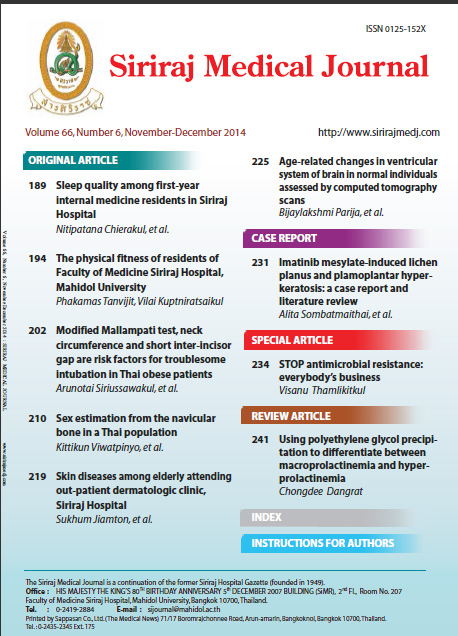Sex Estimation from the Navicular Bone in a Thai Population
Abstract
Foot bones are of interest for forensic sexing because of high reported accuracy in recent studies and often good preservation. This study investigated 202 pairs of navicular bones (104 males, 98 females) obtained from the Chiang Mai University Skeletal Collection. Metric measurements of eight dimensions of the navicular bone were taken with a digital caliper and analysed statistically to determine mean differences between the sexes and to calculate discriminant functions. Discriminant functions obtained from a combination of all variables had a pooled accuracy of 91.1% for the left navicular and 92.1% for the right. Using a stepwise method, discriminant functions showed 89.6% and 92.1% accuracy for left and right bones, respectively. In addition, the functions from stepwise method from either left or right side can be applied to the opposite side with similar obtained accuracy. Variables from the articular facets of the navicular bone had a high effect size and were included in all of our derived discriminant functions. We suggest that detailed measurement of articular facets could be useful for skeletal sexing.Keywords: Forensic anthropology, navicular bone, sex estimation, metric measurement, discriminant analysis
Downloads
Published
How to Cite
Issue
Section
License
Authors who publish with this journal agree to the following conditions:
Copyright Transfer
In submitting a manuscript, the authors acknowledge that the work will become the copyrighted property of Siriraj Medical Journal upon publication.
License
Articles are licensed under a Creative Commons Attribution-NonCommercial-NoDerivatives 4.0 International License (CC BY-NC-ND 4.0). This license allows for the sharing of the work for non-commercial purposes with proper attribution to the authors and the journal. However, it does not permit modifications or the creation of derivative works.
Sharing and Access
Authors are encouraged to share their article on their personal or institutional websites and through other non-commercial platforms. Doing so can increase readership and citations.











